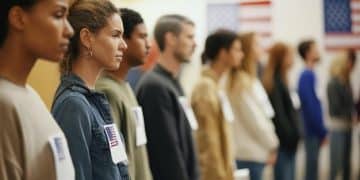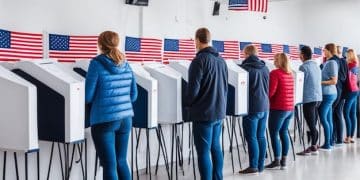Analyzing Voter Turnout Data: Which Demographics are Most Engaged?
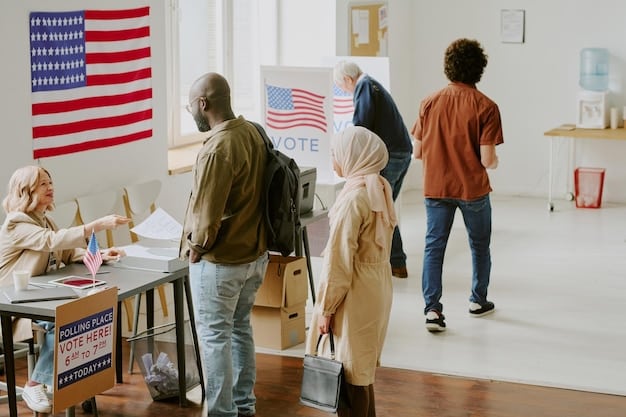
Analyzing the latest data on voter turnout reveals significant variations across demographics, with age, race, education, and socioeconomic status playing crucial roles in determining engagement levels in the US political process.
Understanding voter turnout is crucial for a healthy democracy. This article delves into analyzing the latest data on voter turnout: which demographics are most engaged and why?
Understanding Voter Turnout Trends in the US
Voter turnout—the percentage of eligible voters who participate in an election—is a key indicator of civic engagement and the health of a democracy. Examining recent trends helps us understand who is voting and who is not, providing valuable insights into the factors that influence political participation.
Historical Context of Voter Turnout
Historically, voter turnout in the US has fluctuated significantly. Factors such as amendments to the Constitution, civil rights movements, and major political events have all played crucial roles in shaping who participates in elections.
Recent Election Turnout Rates
Recent elections have seen varying turnout rates among different demographic groups. Understanding these patterns is essential for addressing potential disparities and promoting more inclusive political participation.
- Midterm elections typically see lower turnout than presidential elections.
- Younger voters have historically been less likely to vote than older voters.
- Turnout rates can vary widely by state, reflecting differences in voter registration laws and campaign strategies.
Analyzing these trends requires a comprehensive look at the demographic factors that influence voter behavior. By understanding these underlying causes, policymakers and civic organizations can create targeted strategies to encourage more participation.
Age and Voter Engagement
Age is a significant predictor of voter turnout. Younger and older voters often have different motivations and barriers to participation, affecting their engagement levels.
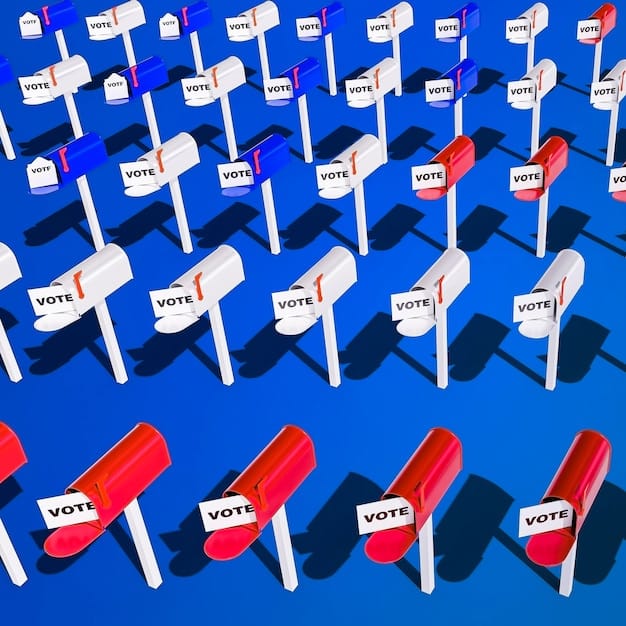
Youth Voter Turnout
Young voters (18-29) have historically had the lowest turnout rates. However, recent elections have shown an increase in youth participation, driven by social and political issues.
Senior Voter Turnout
Senior citizens (65+) typically have the highest turnout rates. Their consistent engagement reflects a lifetime of civic participation and a keen interest in issues affecting their retirement and healthcare.
Understanding these age-related differences is crucial for tailoring outreach efforts. Campaigns and civic organizations must address the specific needs and concerns of each age group to encourage greater participation.
The Role of Race and Ethnicity
Race and ethnicity are critical factors affecting voter turnout. Differences in turnout rates among racial and ethnic groups reflect a complex interplay of historical, socioeconomic, and political factors.
Trends in African American Voter Turnout
African American voters have played a pivotal role in many elections. Recent trends show fluctuating turnout rates, often influenced by specific candidates and policy debates.
Hispanic Voter Engagement
The Hispanic population is one of the fastest-growing segments of the electorate. Understanding their voting patterns and motivations is essential for political campaigns.
- Language barriers can sometimes hinder voter participation among Hispanic communities.
- Immigration policies and related issues often drive Hispanic voter engagement.
- Targeted outreach and culturally relevant messaging are key to increasing turnout in this demographic.
Addressing the unique challenges and opportunities within each racial and ethnic group is essential for promoting more equitable voter participation. This involves culturally sensitive outreach, addressing systemic barriers, and empowering communities to engage in the political process.
Education and Socioeconomic Status
Education and socioeconomic status are closely linked to voter turnout. Individuals with higher levels of education and income are more likely to vote, reflecting greater access to resources and information.
Impact of Education on Voter Turnout
Higher education levels are often associated with increased political knowledge and civic engagement. Educated individuals are more likely to be aware of political issues and understand the importance of voting.
Socioeconomic Disparities in Voting
Socioeconomic factors such as income, employment, and housing stability can significantly impact voter turnout. Lower-income individuals may face barriers such as limited transportation, inflexible work schedules, and lack of access to information.
Addressing these disparities requires multifaceted approaches. This includes initiatives to improve access to education, promote economic opportunity, and reduce barriers to voter registration and participation among disadvantaged communities. Encouraging civic engagement needs to take socioeconomic realities into account to bridge the turnout gap.
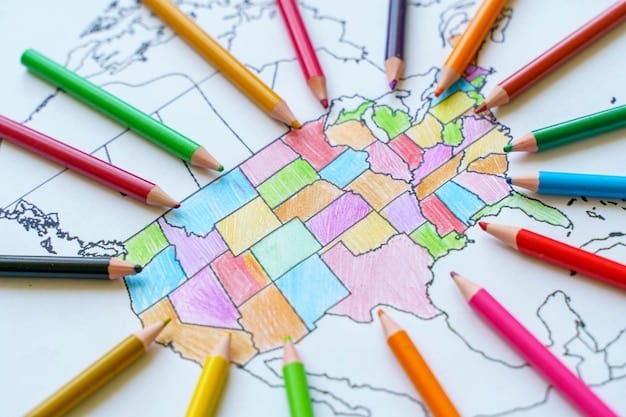
The Influence of Political Interest and Party Affiliation
Political interest and party affiliation are strong predictors of voter turnout. Individuals who are highly engaged in politics and strongly identify with a particular party are more likely to vote.
Role of Political Interest
Individuals with a strong interest in politics are more likely to stay informed about issues, participate in campaigns, and vote consistently.
Impact of Partisan Identification
Strong party affiliation often motivates individuals to vote, as they see it as an opportunity to support their party’s candidates and policies. Partisan divisions can drive turnout in closely contested elections.
- Campaigns often focus on mobilizing their base and encouraging loyal party members to vote.
- Highly polarized political environments can increase voter turnout as individuals feel a stronger need to defend their party’s interests.
- Understanding the motivations and engagement strategies of different parties is crucial for analyzing voter turnout trends.
Fostering political engagement and promoting informed participation are key goals. This involves encouraging critical thinking, providing access to accurate information, and promoting civil discourse across party lines.
Barriers to Voter Turnout and Potential Solutions
Several barriers can hinder voter turnout, including restrictive voter ID laws, limited polling locations, and lack of access to information. Addressing these barriers is essential for promoting more inclusive political participation.
Voter ID Laws and Registration Requirements
Strict voter ID laws and complex registration requirements can disproportionately affect marginalized communities, reducing voter turnout.
Accessibility of Polling Locations
Limited polling locations and long wait times can discourage voters, particularly in urban areas and communities with limited transportation.
- Expanding early voting options can provide more flexibility for voters.
- Implementing automatic voter registration can streamline the process and increase participation.
- Providing accessible polling locations and adequate staffing can reduce wait times and improve the voting experience.
Overcoming these barriers requires collaborative efforts. Policymakers, civic organizations, and community leaders must work together to implement reforms that promote equitable access to the ballot box and ensure that all eligible citizens can exercise their right to vote.
Strategies to Increase Voter Turnout
Several strategies can effectively boost voter turnout, including voter education campaigns, mobilization efforts, and policy changes to make voting easier.
Voter Education and Outreach
Providing voters with accurate information about candidates, issues, and the voting process can increase participation and promote informed decision-making.
Mobilization and Get-Out-the-Vote Efforts
Targeted mobilization efforts, such as phone banking, door-to-door canvassing, and social media campaigns, can effectively motivate individuals to vote. Focusing on historically underrepresented groups can have the biggest impact.
By implementing evidence-based strategies and tailoring efforts to meet the needs of diverse communities, it is possible to create a more inclusive and representative democracy where every voice is heard.
| Key Point | Brief Description |
|---|---|
| 👴 Age & Turnout | Older voters typically have higher turnout rates than younger voters. |
| ✊ Race & Ethnicity | Turnout varies significantly by race and ethnicity, influenced by historical and socioeconomic factors. |
| 🎓 Education & Income | Higher education and income levels are correlated with increased voter turnout. |
| 🗳️ Barriers & Solutions | Addressing barriers like voter ID laws and expanding access can increase turnout. |
Frequently Asked Questions
▼
High voter turnout ensures that elected officials truly represent the will of the people. It leads to more responsive and accountable government, promoting a healthier democracy by including a broader range of voices.
▼
Common barriers include strict voter ID laws, cumbersome registration processes, limited polling locations, and lack of transportation. These obstacles disproportionately affect marginalized communities, hindering their participation in elections.
▼
Voter turnout can be increased through voter education campaigns, simplifying registration processes with options like automatic registration, expanding early voting, and ensuring accessible polling locations with adequate staffing.
▼
Demographics play a significant role, with age, race, education, and socioeconomic status influencing voter turnout. For example, older, more educated, and higher-income individuals tend to vote at higher rates.
▼
Understanding voter turnout trends helps identify disparities and tailor strategies to promote inclusive political participation. It enables policymakers and civic organizations to address the specific needs of various demographics and encourage voting.
Conclusion
Analyzing voter turnout data reveals crucial insights into the dynamics of political engagement in the US. By understanding the demographic factors that influence turnout, addressing existing barriers, and implementing effective strategies to boost participation, we can work towards a more inclusive and representative democracy.
